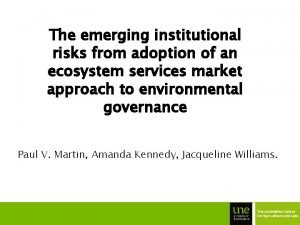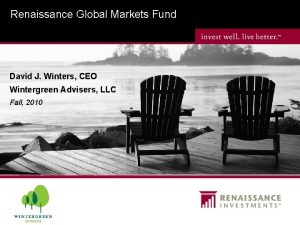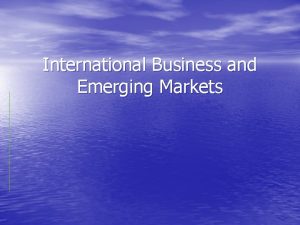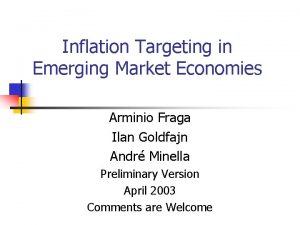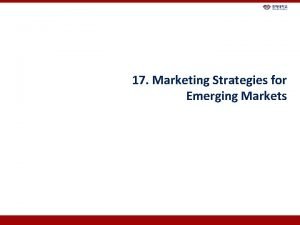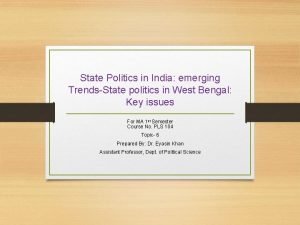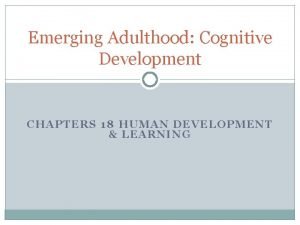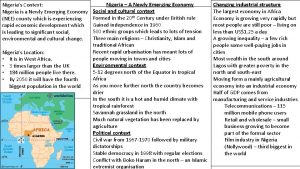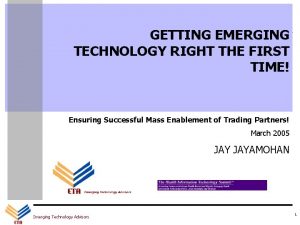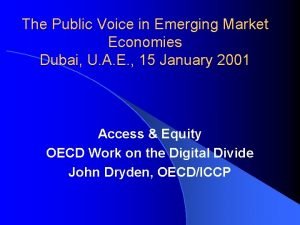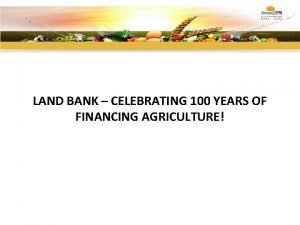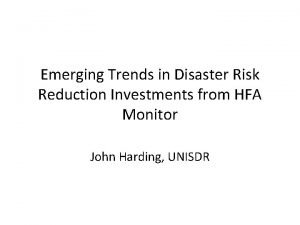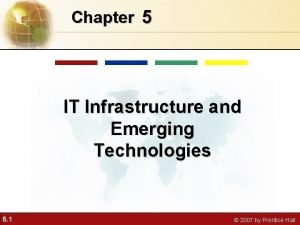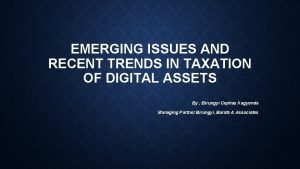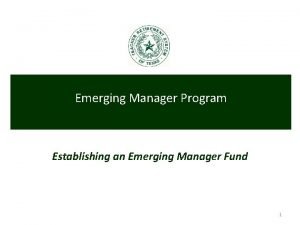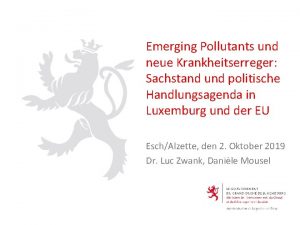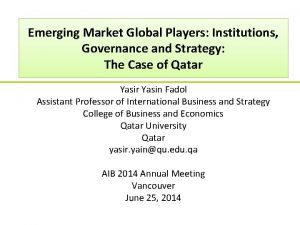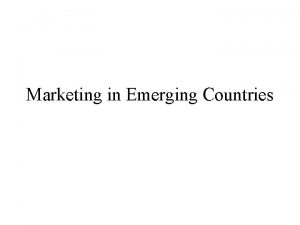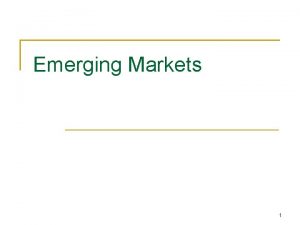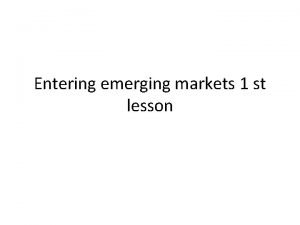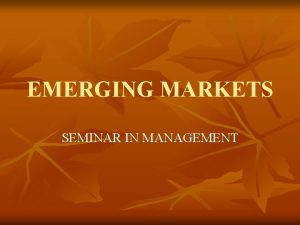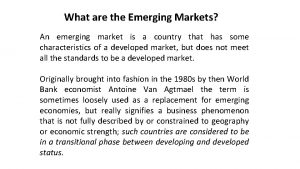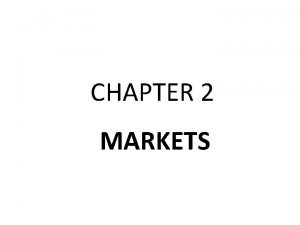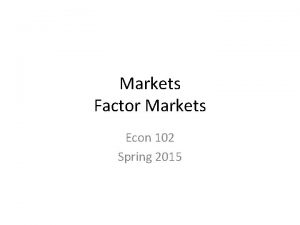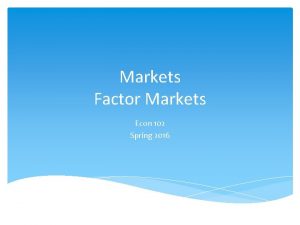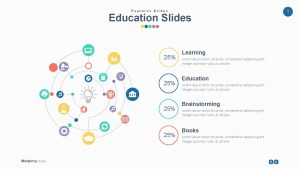Slides course emerging markets EMERGING MARKETS who are






















































- Slides: 54

Slides course emerging markets

EMERGING MARKETS who are they? • BRICS; Brazil, Russia, India , China, South Africa • BRICI; BRIC + Indonesia • STIM; South-Africa, Turkey, Indonesia, Mexico • N 11; Bangladesh, Egypt, Indonesia, Iran, South Korea, Mexico, Nigeria, Pakistan, Philippines, Turkey and Vietnam • TICKS ; China, India , Taiwan , Korea

What is an emerging market ?

EMERGING MARKETS Emerging markets are countries in which the pro-capita income is low. But it is growing strongly…even the growth from an average of 6, 2% in the past decade, it has been only 4% in 2015. Emerging markets represents 56% of the economic global output on a purchasing power parity( 36% on 80’s)

Emerging markets • Philippines ; +6, 7% • Nigeria; +0, 6% • China ; +6, 7% • India +7, 6% • Chile +4, 5% • Indonesia +5, 3% • Brazil 0, 5%

BRIC (China importance ) • In 2004 China was representing 13% of the world growth and the rest of BRIC 9%, with a quite similar growth rate. • In 2013 China was representing 29% of the world growth and the rest of BRIC 7%

Why to enter in the emerging markets

THE BIGGEST GROWTH OPPORTUNITY BY 2025 The annual consumption will be $ 30 trillions In 2010 has been 12 ! Developed countries will be $ 34 trillions, 26 in 2010

WHY TO ENTER IN EMERGING MARKETS • A company need’s to increase turnover yearly ( the productivity is growing by 2 -3% ) and decrease the risks • Growing economies ( in general) • To learn to compete with the new companies in the emrging markets experimenting also new business models

Characteristics and elements to be taken in consideration

CHARACTERISTICS • The total population is 60% of the global one and steady growing • The population is younger than in developed markets >Technology impact • In general fast urbanization. • Labor and natural resources are available at lower costs • The “trigger point” of consumption is around 2000 - 3000 dollars • In China, India, Indonesia, Malaysia, Thailand the people with an income over 3000 dollars have grown by more 40% between 20102015

CHARACTERISTICS • There are big differences between the emerging countries (infrastructures, distribution, duties, laws…)each market has is own identity; China and India case • The markets of the emerging countries are, generally, big in term of population but low in term of consumption pro-capita • A complex array of forces drive growth

THREATS OF THE EMERGING MARKETS • Lower growth than in the past, focusing more on the efficiency than in the past • Big Debt, generaly with a strong dependance from the raw material at least for some countries ( Iran, Arabian Gulf, Russia , Venezuela, Brazil , Nigeria, Angola , Kazhakistan. . )

THREATS OF THE EMERGING MARKETS • Different cultures • Protectionism latent • Fast changes (of the law , the consumption. . ) • Big differences between the markets • Specific products in many cases needed • Strong local competition • Scarcity of the information on the consumer • Modern distribution not always present • Political instability ( at least for some areas)

Emerging markets success rules • The rules of the successes have not changed, they are the classic one’s; • Understanding the consumer. • Build economies of scale. • Design products in line with the price points of the different segments. • Right positioning.

IN WHICH COUNTRY? ; FIVE STEPS • In which countries to focus the analysis • Analysis of the main indicators of the pre-chosen countries • Analysis of the demand • The competition; structure and dynamics • Internal analysis to the company

Analysis of the main indicators • Depends on which categories of products is your business; • - industrial products • - consumer products ; high-midlle or low segment. • Two kind of approaches; • - the contribution of each country at the global development • - to look at the big block of consumption

Analysis of the main indicators • PIL, PIL by inhabitants and their growth • Social demographic split (by age, by income) • Geographic repartition of the population by area , the split between urban and rural (China vs. India) • Dimension and growth of the medium class • Different cultures • Duties and laws on the different products • Political stability • Attitude of the government on the international companies. • Protection on the intellectual property

ANALYSIS OF THE MAIN INDICATORS • Dimension of the market and is potential. • Import duties and the regulations between the countries • Infrastructures • Distribution (traditional or modern ) • Logistic • Advertising costs (taste imprinting ) • Availability of distributors and suppliers • Availability of skilled resources and their costs

IN WHICH COUNTRY • The biggest countries like China , India, Russia, Brazil…are in fact countries with different cultures, level of income in the same country and each area can be considered different • In China the consumers in the three tiers cities are , at least for the moment, more willing to buy local brands than global brands

CHINA • Dimensions: 9. 596. 961 Km • Population: 1. 373. 541. 278 inhabitants (2016 est) • Density: 142, 5 hab/km • Climate: extremely divers, tropical in South and sub arctic in North • 56 Ethnics, Han 92% of the population • $ 21, 27 trillions (2016 est. ) n. 1 in the world in term of PPP ( Purchase power parity) • Pro capita income 15. 400 $ ( 2016. est) • First exporter in the world

CHINA • Strong Growth also in term of income pro capita • Strong urban population, actually 55, 6%, in 2040 70% • Political stability • Good infrastructures (at least for the moment , problems with the growth of the cities ) • Consumer confidence high but decreasing in 2016 • Large number of skilled human resources • Modern trade predominant 62% • City clusters

CHINA EVOLUTION • 18 TH Congress of the Chinese ( 8 Nov. 2012) Communist party fixed the new direction • More Internal consumption and more competition in services (Energies , telecom. health care. . ) in order to push it. • It will be supported by an increase of the productivity in order to support higher wages (between 2004 and 2014 the manufacturing wages almost tripled) • More competition in the financial sector in order to decrease interest rates ( shadow banks)

CHINA EVOLUTION • The traditional bank Loans have accounted more than 90% of the total credit in the last decade , fell to little more than half of new financing in 2013. . • Anticorruption law has impacted the sales of the luxury market end , starting in 2013.

CHINA EVOLUTION • Increase of consumer confidence will push up the consumption , more than the increase of the GDP, due to the reduction of the family saving (estimated from 46% to 36% ) • The development of the services will allow to increase occupation. ( from 51% to 57% ) • The mechanization of the agriculture will push people towards the cities

CHINA EVOLUTION • In the next 10 years the GDP will be equally split between industry and services( 46% ) with agricultural stabilizing around 8% • Strong push in the new energies , less pollution • The bigger push will come from the cities especially the one’s having 1. 5 millions of inhabitants which will represent 40% of the urban development , the one’s between 1. 5 and 5 millions will represent 25% the one’s above 5 millions will represent 35% • The concept of megacities or “clusters” will become very important • Actually 6 Megacities Beijing, Qingdao, Shanghai, Hangzhou, Shenzhen, Chongqing. Within 2025, 3 more including Chengdu

China evolution • A strong increase of the productivity is needed ( actually 15 -30% ) of the most advanced countries in order to push the « virtual circle » • Increase of the R&D expenses between the 2007 and 2015. •

VIRTUAL CIRCLE Population increase Growing demand for goods and services More Confidence Production and productivity increase Increased Income pro capita

China evolution of the situation • Two speed economy ; the traditional ( steel , coal , costructions ) going down. The one based on private consumption , consumer goods , service , e-commerce going up • The 50% of the growth of 2015 came from private consumption very linked to the middle class. and upper midle class.

Actual situation and new Plan • GDP growth ; 6, 7% in 2016 • New 5 years plan based on 10 points; • - Average yearly growth; 5, 6% avearge • - Service business will be 56% of the total within 2020 ( 50, 5% in 2015 ) • - The defense expense will grow only by 7, 5% in 2016 ( the slowest grow of this last years) • The deficit will be 3%in 2016 from 2, 3% of 2015

China New 5 years Plan • The coal Chinese consumption will be no more of 5, 5 billions tons ( 4, 3 billions in 2015 )> strong push towards new energies • Increase of nuclear energy ; 58 gigawat within 2020. • Fast train from 19. 000 km up to 30. 000 km within 2020 • Increase of the GDP person by at least 6, 5% ( 2015 ; 7, 4% )

China 5 year new plan • Elimination of the « Zombies Public companies » . At risk 6 millions of workers (1, 8 milions in steel and coal ) > creation of 15 billions fund. • Target to 60% of urban population ( actually 55, 6% )

China main consequences of the evolution • The rise of the Upper middle-class and affluent ( above 24. 000 $). 81% of the consumption growth within 2020 ( now 116 milions of households are part of this two consumer categories) • The emergence of a new generation • The growing role of e-commerce ( 42 % of all the consumption growth )

Demography a big threat • During 2016 only 11, 3 milions babies are born against 13 milions in 2012. Born rate 1, 05 against a need of 2, 1 • India 25 milions • Impact on the consumption • Problem on the urban population. 250 milions of urban people are above 50 years.

AFRICA • 1, 070 Billions people ( Asia 4, 250 Billions people) • 2000 dialects • 30, 415 millions Km ( Asia 43, 810 Km ) • 35 inhabitants/Km (97 inhabitants /km ) • Very rich in natural resources (10 % of the world wide oil, 40% of the Gold , 80 -90% of Chrome and platinum )

AFRICA ( CONT) • Rural 60%, Urban 40 % within 2025 50% urban( 24 millions additional people will leave in cities every year ) • Countries are very different • Strong Growth of revenue’s ($ 800 billion’s by 2020) mainly coming from the Distribution to the consumer, Telecommunications, Bank and Business link to the infrastructures, Agricultural and natural resources. • The working population is growing by 2, 7% per year ( 1, 3% Latin America, 1, 2% SE Asia) • The B 2 B business will reach $3, 5 Trillions by 2025 Financial servies , construction, utilities, transportation, wholesale and retail trade will be the fastest growing businesses.

AFRICA (CONT) • Very young population, 50% under 20 years old • Optimistic about the future 84 % thinks that it will be better , with the exception of the North Africans • By 2020 the African households which will have discretionary income will rise from 85 million up to 130 million • The big increase will come from the households who have more than $20, 000 • Urban spending is increasing twice as fast as rural spending • The mobile phone penetration has reached 89%

Successes • At least 400 companies have a turnover 1 billion in Africa • Coca Cola , P&G , Unilever have very good market shares in many product categories • Need to look in depth and be very selective about the markets to choose • Focus in some cities or cities clusters • Within 2025, 60% of the consumption will be generated by only 20 cities

Success • Adapting the products? ( Ariel case or Sab Miller…) • To create a very good route to market which can be different by country. • Right timing • Right persons able to work in an informal business environment. Training of the local people is important.

Success of local companies • Focus ; their main target is Africa. They must suceed in order to survive and they develop specific products for this countries • Field ; on the ground experience is very important as the experience of this markets • Facts; superior grasp of informations relevant to the local markets • Flexibility ; comfort with informal business environment.

Examples of local successes • MTN ; Telecomunication South African company which succeed very wellin Nigeria • Biopharma Laboratories; cosmetic compan yvery strong in Cameroon and Cote d’Ivoire • Bidco food company with a very strong market share in Kenya • …. .

Focus in order to develop Africa • Mobilize more domestic resources • Agressively diversify domestic resources • Accelerate infrastucture development • Deepen regional integration • Create tomorrow’s talent • Ensure healthy urbanisation

Mexico • Surface; 1. 964. 000 Km • Population; 123. 000 • Median age ; 28, 0 • Urbanization ; 79, 2% • GDP , 2. 30 $ trillion (12) (P. P. P. • GDP pro capita $18. 900 • Agriculture 3, 7 % of the GDP • Industry 33, 1% • Services 63, 2%

Mexico • In the last three decades transition from a commodity and agricultural based economy to one dominated by manufacturing and services • Firmly situated within North- America supply- chain. • Strongly involved in the Trans-pacific Partnership ( TPP ) and Pacific alliance.

Mexico • Mexico boasts free-trade agreements with over 40 countries. • Trade to GDP ratio who measure the economic openness is over 60% surpassing US, Brazil and China. • Strong growth of the middle class who are confident about the future ( +43 millions people since 2000, 34, 7% of the total population in 2018) • The consumption of Middle Class will represent 42% of the total by 2018.

Mexico • Reforms are needed in order to mantain a growth of 2 - 2, 5%. > positive confidence about the future. • - labor market • - investments in the energy • - improve the efficency of the public services • People will spend more for Healthier products • Consumers will buy more in modern trade

INDIA MAIN FACTS • Climate ; from tropical monsoon to temperate in North • Population 1. 267. 000 ( 2016 July est. ) • Median age 27, 6 • Average growth since 1997 up to 2012 ; 7% • Growth rate 3, 2% ( 2013 est. ) 7, 6% estimation in 2016 • Public debt 51, 7% • GDP 8. 721 Trillions $ (4) (P. P. P. ) est 2016 • GDP pro capita 6. 700 $ ( 2016 est 159 country) • 32. 7%urbanisation

INDIA MAIN FACTS ( CONT. ) • Deficit ; 5, 7% ( 2013 est. ) • Agriculture 16, 5% of GDP , 49% of workers • Industry 29, 8% of GDP , 20% workers • Services 45, 4% of GDP with 31% of workers • 29. 8% poor people • Gross national saving 30. 2% of GDP (31) • Inflation rate ; 5, 6% ( 2016 est) • 200 milions people are connected. In 2018 the estimation will be that 550 milion ( 40% ) of the population will be

REFORMS NEEDED IN INDIA 1) accelerating the jobs creation • 25 millions in manufacturing • 40 millions in services • 50 millions in construction • The farm jobs will represent 37% of the work force in 2022

REFORMS NEEDED IN INDIA • Accelerate critical infrastructure for power and logistics • Reduce the administrative burden on business • Remove tax and markets distortions • Rationalize land market • Take phased steps to make labour markets more flexible

REFORMS NEEDED IN INDIA • Help poor workers build skills with government-funded mechanisms

REFORMS NEEDED IN INDIA ( CONT) 2) Raising farm productivity from 2, 3 T per hectare in 2012 to 4. 0 T 3) Increasing publics spending on basic services ; energy , healthcare, infrastucture 4) Making basic services more effective ( from 50% to 75% )

Where to find the main indicators • The world fact Book • IMF • UN • World Bank

IN WHICH COUNTRY? ; FIVE STEPS • In which countries to focus the analysis • Analysis of the main indicators of the pre-chosen countries • Analysis of the demand • The competition; structure and dynamics • Internal analysis to the company
 Antigentest åre
Antigentest åre Institutional risks
Institutional risks Renaissance emerging markets fund
Renaissance emerging markets fund Risks of doing business in emerging markets
Risks of doing business in emerging markets Challenges of international business in emerging markets
Challenges of international business in emerging markets Emerging markets inflation
Emerging markets inflation Marketing strategies for emerging markets
Marketing strategies for emerging markets Change in energy quick check
Change in energy quick check A small child slides down the four frictionless slides
A small child slides down the four frictionless slides Introduction to machine learning ethem alpaydın
Introduction to machine learning ethem alpaydın Course interne moyenne externe
Course interne moyenne externe One and a half brick wall
One and a half brick wall Course number and title
Course number and title Emerging technologies in ict
Emerging technologies in ict Bridging emerging expanding
Bridging emerging expanding Explain emerging patterns of state politics in india
Explain emerging patterns of state politics in india Swinburne emerging leader
Swinburne emerging leader Atlas of emerging jobs
Atlas of emerging jobs The byzantine empire and emerging europe answer key
The byzantine empire and emerging europe answer key Nhmrc emerging leadership fellow
Nhmrc emerging leadership fellow Recent trends in mis
Recent trends in mis Emerging adulthood cognitive development
Emerging adulthood cognitive development Emerging technology chapter 5
Emerging technology chapter 5 Artificial intelligence devices
Artificial intelligence devices Nigeria newly emerging economy
Nigeria newly emerging economy Emerging technology advisors
Emerging technology advisors Memory technology in computer architecture
Memory technology in computer architecture Soft trends in software engineering
Soft trends in software engineering Jeffrey arnett emerging adulthood theory
Jeffrey arnett emerging adulthood theory An emerging world power
An emerging world power Business intelligence market trends
Business intelligence market trends Emerging technology roadmap
Emerging technology roadmap Emerging adulthood psychosocial development
Emerging adulthood psychosocial development Emerging trends in society
Emerging trends in society Dubai emerging market
Dubai emerging market Emerging technology chapter 4
Emerging technology chapter 4 Chapter 5 it infrastructure and emerging technologies
Chapter 5 it infrastructure and emerging technologies Land bank funding for emerging farmers
Land bank funding for emerging farmers Emerging technology chapter 5
Emerging technology chapter 5 How to write california eld standards
How to write california eld standards Jeffrey arnett emerging adulthood theory
Jeffrey arnett emerging adulthood theory Emerging trends in disaster mitigation
Emerging trends in disaster mitigation World heart federation emerging leaders
World heart federation emerging leaders Emerging technology chapter 5
Emerging technology chapter 5 Emerging issues in taxation
Emerging issues in taxation Emerging sources citation index means
Emerging sources citation index means Leo iii outlawed crucifixes as idolatry
Leo iii outlawed crucifixes as idolatry Introduction to industrial relations
Introduction to industrial relations List of emerging manager programs
List of emerging manager programs Emerging proficient extending
Emerging proficient extending Challenges of emerging trends in operating systems
Challenges of emerging trends in operating systems Grundwasserreinigung emerging contaminants
Grundwasserreinigung emerging contaminants Chapter 22 life in the emerging urban society
Chapter 22 life in the emerging urban society Art of emerging europe ppt
Art of emerging europe ppt Pengertian emerging market
Pengertian emerging market

